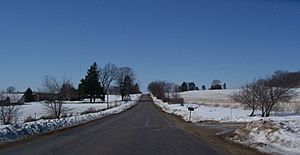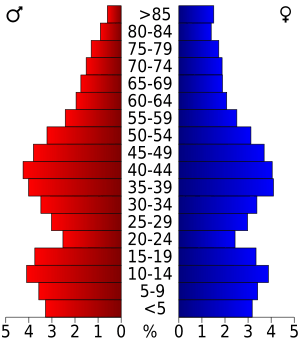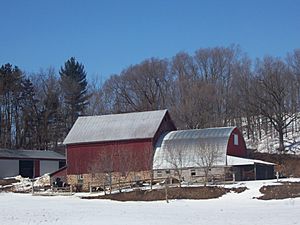Sauk County, Wisconsin facts for kids
Quick facts for kids
Sauk County
|
|
|---|---|
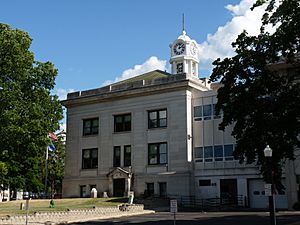
Sauk County Courthouse in June 2012
|
|
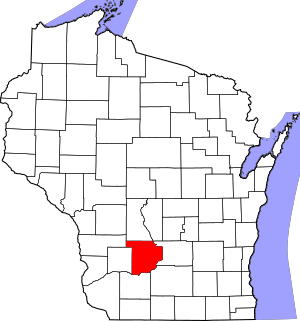
Location within the U.S. state of Wisconsin
|
|
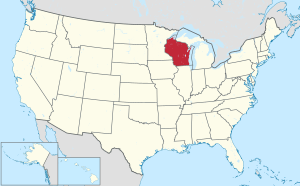 Wisconsin's location within the U.S. |
|
| Country | |
| State | |
| Founded | 1844 |
| Named for | Sauk people |
| Seat | Baraboo |
| Largest city | Baraboo |
| Area | |
| • Total | 849 sq mi (2,200 km2) |
| • Land | 831 sq mi (2,150 km2) |
| • Water | 18 sq mi (50 km2) 2.1%% |
| Population
(2020)
|
|
| • Total | 65,763 |
| • Estimate
(2023)
|
65,920 |
| • Density | 77.46/sq mi (29.907/km2) |
| Time zone | UTC−6 (Central) |
| • Summer (DST) | UTC−5 (CDT) |
| Congressional district | 2nd |
Sauk County is a county located in Wisconsin. It got its name from a large village of the Sauk people. In 2020, about 65,763 people lived there. The main city and county seat is Baraboo. The county was formed in 1840 from Wisconsin Territory and officially started in 1844. Sauk County is part of the Baraboo, WI Micropolitan Statistical Area and is also included in the larger Madison metropolitan area.
Contents
History of Sauk County
Sauk County was first settled by people from New England. Many of these early settlers also came from upstate New York. Their parents had moved to New York after the American Revolution. These settlers were called "Yankee" settlers. They were descendants of the English Puritans who settled New England in the 1600s.
Most of them came to Wisconsin directly from New England. Others came from upstate New York. They were part of a large group of New England farmers. These farmers moved west into the Northwest Territory in the early 1800s. For Wisconsin, this big move mostly happened in the 1830s. Because so many New Englanders moved there, Wisconsin's culture was very similar to early New England culture for a long time.
Why People Moved to Wisconsin
Many things caused the Yankee migration to Wisconsin in the 1830s. One reason was that New England was becoming too crowded. Yankee families often had many children, sometimes up to ten. Most people wanted their own land to farm. But with so many people, land in New England became hard to find. There wasn't enough land for every family to have a farm that could support them. So, Yankee settlers started moving to the Midwestern United States.
Travel to the Midwest became much easier when the Erie Canal was finished. This caused even more people to move from New England. Also, the end of the Black Hawk War made the region safer for white settlers to travel and live in.
Building a New Life
The settlers reached what is now Sauk County in the 1830s. They sailed up the Wisconsin River from the Mississippi River. They used small boats they built themselves from wood found nearby. When they arrived, the area was mostly thick, untouched forest. The "Yankee" New Englanders started building farms. They also built roads, government buildings, and postal routes.
They brought their Yankee New England values with them. This included a strong belief in education. They built many schools. They also strongly supported ending slavery. Most of them belonged to the Congregationalist Church. Some were Episcopalian. Because of the second Great Awakening, some had become Methodists or Baptists before moving to Sauk County. Sauk County, like much of Wisconsin, kept a strong New England culture for many years.
New Immigrants Arrive
In the late 1890s, German immigrants began to settle in Sauk County. Before this time, very few German settlers lived there. Generally, the German and "Yankee" settlers got along well. However, they sometimes disagreed on certain issues. One big disagreement was about banning alcohol. On this topic, the Yankees were split, but the Germans were almost all against banning alcohol. This helped stop prohibition.
Later, the two groups disagreed about World War I. Again, the Yankee community was divided. The Germans were all against America joining the war. Many Yankees were generally supportive of Britain. But many also did not want America to enter the war itself. The Germans felt sympathy for Germany. They did not want the United States to fight against Germany. However, the Germans were not against Britain. Before World War I, many German leaders in Wisconsin said how much better America was than Germany. They liked that America had English laws and political culture. They compared this to the problems and unfairness they had left behind in Germany. In the early 1900s, immigrants from Ireland, Sweden, Norway, and Poland also came to Sauk County.
Baraboo: Circus City
The area around Baraboo was first settled by Abe Wood in 1838. It was first known as the village of Adams. In 1846, it became the county seat of Sauk County. This happened after a big competition with the nearby village of Reedsburg. In 1852, the village was renamed "Baraboo" after the nearby river. It officially became a city in 1882.
Early New England settlers built several sawmills in Baraboo. This was because of its good location near the Baraboo and Wisconsin Rivers.
Baraboo was the home of the famous Ringling brothers. From 1884 to 1917, it was the main base for their circus and other circuses. This led to Baraboo being called "Circus City." Today, the Circus World Museum is located in Baraboo. It is a living history museum. It has a large collection of circus wagons and other circus items. It also has the biggest library of circus information in the United States. The museum used to host the Great Circus Parade. This parade moved circus wagons and performers through Baraboo's streets. Then, they traveled by train across the state to downtown Milwaukee.
The Al. Ringling Theatre is a beautiful movie theater in downtown Baraboo. The Ringling family helped pay for it. The original home of Al Ringling can still be seen today.
Near Baraboo is the Badger Army Ammunition Plant. During World War II, it was called "Badger Ordnance Works." It was the largest munitions (ammunition) factory in the world. The plant is not used anymore.
The Culver's restaurant chain has its main office in Prairie du Sac. The first Culver's restaurant opened in Sauk City in 1984. In the same year, Cirrus Aircraft was started in a barn near Baraboo. Brothers Alan and Dale Klapmeier founded the company. They wanted to make the VK-30 kit aircraft. Cirrus Aircraft is now based in Duluth, Minnesota.
Geography of Sauk County
The U.S. Census Bureau says that Sauk County covers about 849 square miles. About 831 square miles are land, and 18 square miles (2.1%) are water. Pewits Nest is a natural area found in Sauk County. Sauk Point is the highest place in the county. This peak is located in the Baraboo bluffs. It stands about 1,593 feet above sea level.
Main Roads
 Interstate 90
Interstate 90 Interstate 94
Interstate 94 U.S. Highway 12
U.S. Highway 12 U.S. Highway 14
U.S. Highway 14 Highway 13
Highway 13 Highway 16
Highway 16 Highway 23
Highway 23 Highway 33
Highway 33 Highway 58
Highway 58 Highway 60
Highway 60 Highway 78
Highway 78 Highway 113
Highway 113 Highway 130
Highway 130 Highway 136
Highway 136 Highway 154
Highway 154
Rail and Bus Travel
- Canadian Pacific (trains)
- Wisconsin and Southern Railroad (trains)
- Baraboo Transit (buses)
Airports in the County
- Baraboo-Wisconsin Dells Airport (KDLL) serves the county and nearby areas.
- Tri-County Regional Airport (KLNR)
- Sauk–Prairie Airport (91C)
- Reedsburg Municipal Airport (C35)
Neighboring Counties
Sauk County shares borders with these counties:
- Juneau County - to the north
- Adams County - to the northeast
- Columbia County - to the east
- Dane County - to the southeast
- Iowa County - to the south
- Richland County - to the west
- Vernon County - to the northwest
People of Sauk County
| Historical population | |||
|---|---|---|---|
| Census | Pop. | %± | |
| 1840 | 102 | — | |
| 1850 | 4,371 | 4,185.3% | |
| 1860 | 18,963 | 333.8% | |
| 1870 | 23,860 | 25.8% | |
| 1880 | 28,729 | 20.4% | |
| 1890 | 30,575 | 6.4% | |
| 1900 | 33,006 | 8.0% | |
| 1910 | 32,869 | −0.4% | |
| 1920 | 32,548 | −1.0% | |
| 1930 | 32,030 | −1.6% | |
| 1940 | 33,700 | 5.2% | |
| 1950 | 38,120 | 13.1% | |
| 1960 | 36,179 | −5.1% | |
| 1970 | 39,057 | 8.0% | |
| 1980 | 43,469 | 11.3% | |
| 1990 | 46,975 | 8.1% | |
| 2000 | 55,225 | 17.6% | |
| 2010 | 61,976 | 12.2% | |
| 2020 | 65,763 | 6.1% | |
| U.S. Decennial Census 1790–1960 1900–1990 1990–2000 2010–2020 |
|||
Population in 2020
Based on the 2020 census, Sauk County had 65,763 people. This means there were about 79.1 people living per square mile. There were 30,784 homes, with about 37.0 homes per square mile.
The people living in the county were made up of different groups:
- 89.1% White
- 1.3% Native American
- 0.9% Black or African American
- 0.6% Asian
- 3.1% from other races
- 4.9% from two or more races.
About 6.2% of the population was Hispanic or Latino of any race.
Communities in Sauk County
Cities
- Baraboo (This is the county seat, where the main government offices are.)
- Reedsburg
- Wisconsin Dells (Most of this city is in other counties like Columbia, Adams, and Juneau.)
Villages
- Cazenovia (Part of it is in Richland County.)
- Ironton
- La Valle
- Lake Delton
- Lime Ridge
- Loganville
- Merrimac
- North Freedom
- Plain
- Prairie du Sac
- Rock Springs
- Sauk City
- Spring Green
- West Baraboo
Towns
Census-Designated Places
These are areas that are like towns but are not officially incorporated as cities or villages.
- Bluffview
- Lake Wisconsin (Only part of it is in Sauk County.)
Other Unincorporated Communities
These are smaller communities that are not officially part of a city, village, or town.
- Black Hawk
- Cassell
- Crawford Crossing
- Dellwood
- Denzer
- Greens Corners
- Hill Point
- La Rue
- Leland
- Loddes Mill
- Loreta
- Moon Valley
- Sandusky
- Valton
- Witwen
Economy and Jobs
The biggest employer in Sauk County is the Ho-Chunk Nation. They employ about 3,100 people in both Jackson and Sauk counties combined.
See also
 In Spanish: Condado de Sauk para niños
In Spanish: Condado de Sauk para niños


